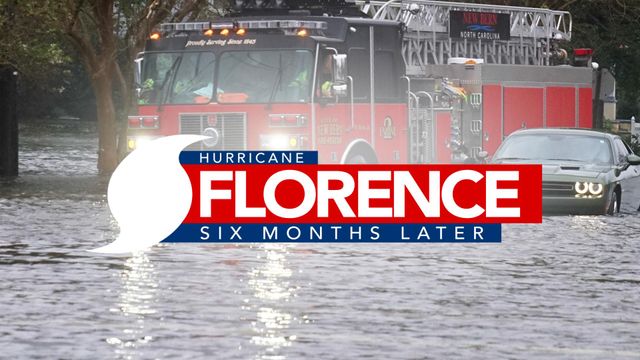Nearly $78M sent to NC schools struggling with hurricane damage; see where the money went
The state of North Carolina has sent nearly $78 million to school districts that are struggling with damage from Hurricane Florence. Another $17 million has yet to be distributed.
North Carolina Superintendent of Public Instruction Mark Johnson released data Thursday showing which school systems have received the money. He reminded residents that "everything is not back to normal" for many schools that were affected. This week marks six months since Hurricane Florence made landfall.
"We’re not that far removed from this major storm, yet many in North Carolina may have moved on and forgotten its long-term effects,” Johnson said in a statement.
Onslow County Schools has received the most money so far – about $21.7 million. The hurricane damaged hundreds of schools in North Carolina, permanently closed two schools and caused more than 5,000 students to be homeless, according to the superintendent's office.
{
"name": "footable",
"attrs": {
"id": "18259318",
"identifier": "Florence",
"placeholder": "Search for your school district",
"limit": "5",
"phone": "Round 1|Round 2|Round 3 (ongoing)",
"header": "Hurricane Florence disaster recovery funds",
"credits": "Source: N.C. Department of Public Instruction (money distributed as of March 14, 2019)"
},
"children": null
}"We estimate that the number of students who missed at least a week of school is 340,000 – that’s larger than the entire populations of Winston-Salem and Asheville combined," Johnson said. "I have seen schools where portions of the building were entirely flooded. I have seen mold and mildew damage that made schools unsuitable. But, I have also seen the resilience and determination to get back to normal. Our public schools are so important to their communities, and we owe it to them to support ongoing recovery efforts."
State school nutrition staff estimate that 50,000 students in disaster counties have benefited from a waiver the state education department sought and obtained from the U.S. Department of Agriculture that allowed schools to provide meals at no cost to all students during the disaster recovery phase.
"Teachers worked to locate students. Principals and local superintendents went from hosting emergency shelters in schools to trying to find usable space to reopen for returning students," according to the superintendent's office. "Perhaps the most overlooked on-the-ground heroes were the school nutrition workers, who – while they were not even sure they would be paid for the work – made meals available to all students who needed them. In some cases, food was even airlifted into flooded areas."
Claims from Florence
Select a county below to see losses from Hurricane Florence based on claims for residential property tracked by the N.C. Department of Insurance as of November 2018.
Loading map

In Wake County, residents filed 4,234 claims for a total of $21,979,855 in losses. That's about $5,191 per claim, or $20.89 per person based on the population of the county.
State leaders made $95 million available to local school districts so schools could reopen in the wake of the storm. On Oct. 15, the General Assembly appropriated $35 million to add to the $25 million Gov. Roy Cooper made available Oct. 8. On Dec. 3, the General Assembly provided an additional $35 million. The legislature has also ensured that all school personnel paid through state funds will receive pay if they missed a day due to the storm and would have been scheduled to work that day, according to the superintendent's office.
Former state superintendent Mike Ward was joined by a bipartisan group of state education leaders to establish Florence Aid to Students and Teachers – FAST NC, which has made more than $1 million available to aid schools in recovery efforts.
The group continues to accept donations and review applications for assistance from educators in the affected areas. The FAST NC funds are meant to supplement what insurance and state and federal disaster relief will not cover. Many insurance contracts have a monetary cap on smaller items such as rugs, books that aren’t textbooks, and other classroom items that make a classroom into a second home for students, according to the superintendent's office.
FAST NC grants have been awarded across the affected counties and range from $82,000 to refit Jones County schools to $760 to Whiteville Central Middle School to replace damaged student exercise equipment. Under the FAST NC model, teachers can submit individual requests to the FAST NC committee if the request is approved first by the local superintendent.
State superintendent Johnson will visit Town Creek Elementary School in Winnabow, Brunswick County, on Friday to observe the six-month anniversary of Hurricane Florence making landfall. The school was one of the hardest hit in Brunswick County and was closed until mid-October. Johnson will tour the school to view repairs, visit classrooms and teachers, and deliver books for the students. He will also deliver letters from third-graders in Morganton.












